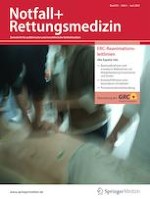Erschienen in:

02.06.2021 | Kardiopulmonale Reanimation | ERC Leitlinien
Zur Zeit gratis
Versorgung und Reanimation des Neugeborenen nach der Geburt
Leitlinien des European Resuscitation Council 2021
verfasst von:
John Madar, Charles C. Roehr, Sean Ainsworth, Hege Ersda, Colin Morley, Mario Rüdiger, Christiane Skåre, Tomasz Szczapa, Arjan te Pas, Daniele Trevisanuto, Berndt Urlesberger, Dominic Wilkinson, Jonathan P. Wyllie
Erschienen in:
Notfall + Rettungsmedizin
|
Ausgabe 4/2021
Einloggen, um Zugang zu erhalten
Zusammenfassung
Die vorliegenden Leitlinien des European Resuscitation Council zur Versorgung und Reanimation des Neugeborenen nach der Geburt beruhen auf dem International Liaison Committee on Resuscitation (ILCOR) 2020 Consensus on Science and Treatment Recommendations (CoSTR) for Neonatal Life Support (NLS). Sie beinhalten Empfehlungen zur Versorgung und Reanimation des reifen Neugeborenen und zur Stabilisierung des Frühgeborenen. Sie umfassen den aktualisierten Algorithmus zur Reanimation des Neugeborenen, die Vorbereitungen vor der Versorgung eines Neugeborenen, die Themen Training und Ausbildung, Wärmemanagement, Empfehlungen zum Abnabeln, die initiale Beurteilung und Einschätzung des Neugeborenen, das Atemwegsmanagement, inklusive einer Notfallbeatmung, und die Kreislaufunterstützung im Falle einer vollen Reanimation. Darüber hinaus finden sich Empfehlungen zur Kommunikation mit den Eltern und ethische Überlegungen, in welchen Situationen erwogen werden soll, auf Reanimationsmaßnahmen zu verzichten bzw. Reanimationsmaßnahmen nicht fortzuführen.











